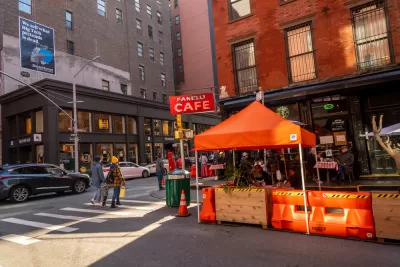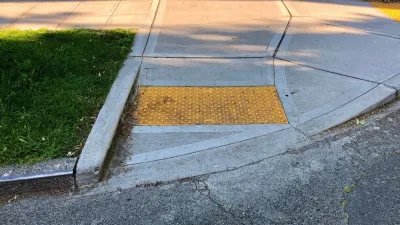The rush to utilize sidewalk space for outdoor seating and parklets has created new obstacles for people with disabilities.

Although the "open streets" movement brought a new sense of freedom to many pedestrians, people with disabilities have found themselves running up against a new set of obstacles. According to Peneliope Richards, a writer with cerebral palsy, "[p]lenty of outdoor dining setups act as sidewalk obstacle courses." As John Surico reports in Bloomberg CityLab, "[n]avigating commercial stretches packed of streateries, parklets and other Covid adaptations has often exacerbated the existing challenges faced by wheelchair users and others with mobility impairments."
While parklets and outdoor seating programs were designed to provide more public space, "as many of these street changes are being made permanent, advocates are fighting to ensure that that space is expanded equitably." Eman Rimawi, an organizer for New York Lawyers for the Public Interest, says cities should be more proactive in enforcing ADA compliance and figuring out where parklets and outdoor seating can go without posing accessibility problems. "On streets with extensive outdoor dining — now made permanent by City Hall — planners should analyze where sidewalks can safely be expanded. The parking-spot parklets, she said, open up the possibility of converting even more street space to pedestrian usage," creating more public space without crowding the city's sidewalks.
Ensuring accessibility also helps increase visibility for people of all abilities, says Alan Benson, a wheelchair user in London. Inclusion, he says "means allowing everyone to participate in urban society, so everyone else notices."
FULL STORY: For Disabled Users, the ‘Open Streets’ of the Pandemic Remain Closed

Alabama: Trump Terminates Settlements for Black Communities Harmed By Raw Sewage
Trump deemed the landmark civil rights agreement “illegal DEI and environmental justice policy.”

Planetizen Federal Action Tracker
A weekly monitor of how Trump’s orders and actions are impacting planners and planning in America.

The 120 Year Old Tiny Home Villages That Sheltered San Francisco’s Earthquake Refugees
More than a century ago, San Francisco mobilized to house thousands of residents displaced by the 1906 earthquake. Could their strategy offer a model for the present?

In Both Crashes and Crime, Public Transportation is Far Safer than Driving
Contrary to popular assumptions, public transportation has far lower crash and crime rates than automobile travel. For safer communities, improve and encourage transit travel.

Report: Zoning Reforms Should Complement Nashville’s Ambitious Transit Plan
Without reform, restrictive zoning codes will limit the impact of the city’s planned transit expansion and could exclude some of the residents who depend on transit the most.

Judge Orders Release of Frozen IRA, IIJA Funding
The decision is a victory for environmental groups who charged that freezing funds for critical infrastructure and disaster response programs caused “real and irreparable harm” to communities.
Urban Design for Planners 1: Software Tools
This six-course series explores essential urban design concepts using open source software and equips planners with the tools they need to participate fully in the urban design process.
Planning for Universal Design
Learn the tools for implementing Universal Design in planning regulations.
Clanton & Associates, Inc.
Jessamine County Fiscal Court
Institute for Housing and Urban Development Studies (IHS)
City of Grandview
Harvard GSD Executive Education
Toledo-Lucas County Plan Commissions
Salt Lake City
NYU Wagner Graduate School of Public Service





























